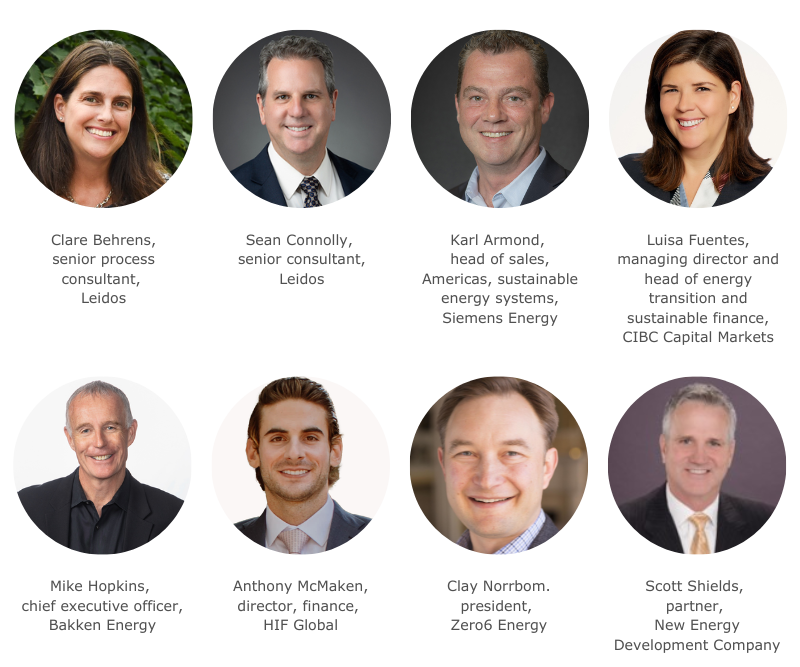US hydrogen’s route to bankable
What needs to happen for hydrogen to become a mainstream project finance asset in the US? A panel of lenders, developers and advisers gathers to discuss risk allocation and development and financing strategies.

Supported by
 A combination of increased government support and increased interest from investors and offtakers have pushed hydrogen ever closer to the mainstream. It’s a proven technology – though debates persist about how proven – and enjoys strong support in recent legislation. But hydrogen is a fast-moving market, with evolving terms for construction and offtake agreements, and the market has yet to witness a large-scale hydrogen project financing. And those generous incentives will themselves create challenges in structuring and financing projects.
A combination of increased government support and increased interest from investors and offtakers have pushed hydrogen ever closer to the mainstream. It’s a proven technology – though debates persist about how proven – and enjoys strong support in recent legislation. But hydrogen is a fast-moving market, with evolving terms for construction and offtake agreements, and the market has yet to witness a large-scale hydrogen project financing. And those generous incentives will themselves create challenges in structuring and financing projects.
Proximo, with the support of Leidos, brought together a group of experts active in the sector to discuss the next steps for hydrogen – of all colours – in the US project finance market.
Roundtable participants

Proximo: Let's talk about green hydrogen’s revenue models first. Which ones do you like the look of most?
Luisa Fuentes, CIBC (LF): It won’t be any surprise when I say that lenders prefer long-term fixed price contracts, particularly when they're wrestling with novel technologies, even if they’re proven. And none of these are small scale projects. If you are looking to raise between $300 million and $500 million you might be able to work with something that's a little more creative on the revenue model side. But when it comes to multiples in the billions, the tighter your contracts, the better. A revenue structure where you can pass through any variable commodity costs will be viewed favourably. A tolling model would be ideal, and obviously a lot of these projects also include tax credits, so monetising those in a predictable way would be helpful. You’ll be trying to figure out how to size debt for contracted production tax credits compared to uncontracted.
Scott Shields, New Energy Development Company (SS): I really think it depends on the market. The easy button is a fixed price offtake. But that doesn't solve margin risk. Long-term fixed prices significantly expose margins to their biggest input cost, which is power on the green hydrogen side. That risk can be solved with tolling, but the traditional offtakers are used to the model from grey hydrogen, which uses a floating gas price with a floor, with the price based on a monthly delivered price of gas, plus a fuel charge which takes care of their margin risk. So there’s a cost collar between about $4.75 and $6, and there can be a very handsome upside on that. For new assets the traditional users might be willing to look at a 15-year contract. Anything else is five years.
Mike Hopkins, Bakken Energy (MH): If you’re working at a large scale and really trying to drive down costs then you need to look as normal as possible. If you’re developing blue hydrogen, so hydrogen derived from natural gas with carbon capture and sequestration, you’ve got the advantage of your feedstock being an established commodity. Offtakers and the markets are used to a long-term offtake being indexed to natural gas prices. But this is a whole new market, and can be unpredictable. Federal support – including loan guarantees on the debt side, grants and PTCs – will be important, and you want your project to be set up in such a way that when it comes to the equity, it looks like a project financing that’s familiar to them, as well as the offtakers.
Proximo: Does the evolution of hydrogen look a lot like LNG, with indexation to a less relevant benchmark persisting even as the market moves on?
MH: It’s a good analogy, though LNG had the advantage of being a familiar commodity. There will be big benefits to the wider hydrogen development community – regardless of how that hydrogen is being produced – from early developments in natural-gas derived hydrogen. This will include the development of infrastructure such as storage, pipelines and liquefaction. As the hydrogen economy evolves, hydrogen infrastructure goes from being isolated pioneer settlements to a better connected grid that drives down the costs of plugging in for everybody.
Anthony McMaken, HIF (AM): We use LNG as the most common way to get our message over to lenders and new investors, and I personally spent ten years at Cheniere. We’re targeting a structure to look a little like that, with fixed-price contracts that may not be the 20+ years you see in LNG, but something more like 10 - 15, which would be more closely in line with the tenor of the PTC. Construction is also likely to be a bit different, given that you probably can’t get a full wrap on a hydrogen facility yet, but we are trying to lock down every single cost component during construction and during the first ten years of operations. But LNG is a very good example of the risk mitigation processes, and structurally it will look very similar from a project finance standpoint.
LF: Some of the early projects we’re seeing in Saudi Arabia and the US do remind me of what the majors did with LNG in Asia-Pacific early on, where they put a lot of corporate support behind the technologies as they developed.
Proximo: What sort of customers look most appealing?
Karl Armond, Siemens Energy (KA): There are a lot of ingredients that come together. A lot of developers from the green generation space are looking to move into hydrogen, whether it's a distributed production as opposed to centralized, but with the Federal tax credits and other incentives the scale of the projects has grown enormously. What were 10-60MW opportunities are now hundreds of megawatts, if not tending towards gigawatts. Banks are expecting the norms what they've seen in the past, especially with new technologies, like offshore wind, for example, or LNG. They’re setting expectations about what OEMs will do to support a developer through the payback period.
Proximo: Is this a question of finding a nice balance sheet to park these risks on?
Clay Norrbom, Zero6 Energy (CN): Our project is a necessary stepping stone to an interest in very large projects. We're building a 20MW electrolyser green hydrogen project, and we're finding ourselves taking a lot of first steps, whether it's technology, suppliers, and so on. We're relatively conservative and try to lock down risk where we can. Our offtake agreements are long term and tolling-type arrangements, with a customer who needs 24-7 hydrogen. There is some resilience in that arrangement, so we can market some surplus, but given there's enough risk overall in our projects, we're trying to keep it simple from a contract perspective, so we’ll try to pass on as much of the electricity risk as we can.
Proximo: Clare, how would you view the stack of risks attached to hydrogen?
Clare Behrens, Leidos (CB): Hydrogen risks fall into the broad categories of technology, project execution and operational risks. On the technology side, electrolysis has been around for over 100 years, and the processes that typically utilize hydrogen, such as ammonia, methanol or synthetic fuels production, have been around for a very long time. So the key is selecting a technology provider for electrolysis that has done extensive testing, so that there is data available to demonstrate that the electrolysers will perform as expected, when they are brand new, as well as how they will perform over time as they degrade, and how often you need to replace the stack components. On the project execution side, I think lenders are going to expect to see an EPC structure that provides cost and schedule certainty similar to any other project. On the operational side, the main risks come down to contractual structures, both on the offtake side, and also on the electricity side in terms of being able to lock in fixed prices.
Proximo: Let’s look now at another part of the cost equation, and that’s the price of technology. We have heard of long lead times for electrolysers, and inflation is an issue throughout the energy and infrastructure market. What are the best ways of mitigating these issues? Can you park them on someone’s balance sheet? Make projects a bit more modular? Line up your suppliers early?
CB: There will need to be a combination of the strategies, but most important is having your manufacturing capacity reserved early, though it's going to be a challenge, as manufacturing capacity continues to ramp up. The earlier projects that have locked in capacity will have an advantage over other projects that are just now trying to get in the door and calling on suppliers that are very busy fielding calls from all over the world.
SS: There are some incumbents who have been in the business for quite some time, but even with these incumbents, it's a moving target in terms of when overhauls are needed. Performance Guarantees are tough to come by. There’s some potential for newer electrolyser technologies that would require feewer precious metals. But electrolysers are about 25% of a project cost, while electricity is by far the biggest one, and can be upwards of 60 or even 65% of the total cost depending on economies of scale and on local power prices, obviously. Variable renewables resources, and price spikes, will be a big risk factor, but green power is important in qualifying for the $3 PTC. Which brings up another issue, and that’s the tax credit risk. Lenders as well as equity providers are extremely nervous at the potential for repeal or at the very least how the IRS is going to implement the IRA, because 48C and 45V incentives are going to be integral to the financing and the profitability to these projects, not to mention the interpretation of Section 6418 and the ability to turn credits into cash payments.
Proximo: Let’s look at the tax credit angle now. They’ve been a huge complicating factor in financing renewables. How does the hydrogen industry structure around them?
MH: The $3 PTC requires very, very low carbon intensity and there's a lot of projects that don't work without it. It may be very difficult, even for a so-called green hydrogen project to achieve that unless they only use renewables. I think the rule could be watered down so you can be connected to the grid, you can buy offsets, you can do it maybe hourly. I think it takes a huge number of projects off the board, at least the smaller ones. The very large projects based on natural gas with carbon capture don't need the production tax credit, though it increases the return, and it is possible to deploy technology to get natural gas projects to that level of eligibility.
Proximo: Is hydrogen going to be a big part of the solution to curtailment for renewables. Essentially as storage?
MH: I don’t think it’s going to be competitive with lithium-ion batteries for 2- to 4-hour storage. If a market develops for long-term energy storage of over 8 hours and ideally even seasonal, which is what integrated resource planners predict, then storage could be a very high value use for hydrogen.
Sean Connolly, Leidos (SC): I agree that there will not be a need in the near term for hydrogen as long-term storage. When you get past 80% renewables penetration to the last part of the utility space you need to decarbonise then you start to need that. There might be some opportunities for blending with natural gas, either in a gas pipeline for gas utilities, or just on the generation side.
CN: We do have a connected wind project, but we are grid connected as well, so we have a lot of optionality. We don't know where things are going to turn out with the IRS interpretations, and subtle changes could have tremendous effects on green hydrogen projects. Some of these can be managed through contracts or be priced back to end-customers, but it is hard to design a project within the current parameters, and so unless you have a little bit of optionality then there’s going to be paralysis.
KA: Our generation customer base have all looked at their existing plants and what it would take to bring hydrogen on board from a footprint perspective, a consumption of water perspective and a roundtrip efficiency perspective. It is clear to us as an OEM of turbines, moving towards 100% hydrogen capability in 2030 across the fleet of machines and having retrofittable combustion systems for the existing fleet, that it will be a big part of the solution in the future but not immediately. Some of the DOE hub applicants are looking to have some level of co-generation or co-blending and co-firing, but it probably won't result in re-electrification of hydrogen through combustion at scale in the short term. Such capability is becoming a consideration for permits, and the financial community wants to see it, but the infrastructure still has a long way to go.
Proximo: Integrating hydrogen into existing natural gas infrastructure is not straightforward, is it?
KA: Blending to a certain level is obviously possible, and to certain limits of metallurgy, but in the long run there will be hydrogen networks in existence. There already are some hydrogen pipelines in existence that operate well, but they were designed from the get-go to be hydrogen pipelines. Utilizing otherwise curtailed renewables is really the path to scale, but decarbonization of transport and of industry are going to be the precursor, providing demand for a fully interconnected system.
AM: The hydrogen production tax credit is crucial to projects in the US being able to work at scale. But we can look at how difficult it’s becoming in Europe to qualify under the Delegated Acts and Red III for renewable fuel incentives. At the moment the beauty of the US system is that the carrot is more important than the stick, whereas it’s different in Europe. Hourly matching and additionality requirements for the 45 credits would mean that you're effectively paying full price to build out a hydrogen facility just to be able to operate it at whatever the capacity factor is in the region you're in. NGOs were pushing for some of these same rules in the US, but they are not the ones putting the steel in the ground. Another issue is that the 45 credits are paid once a year, and have to wait for a tax return to be filed, so there will be a year of no cashflows from that credit during the first year of operations, and debt will need to be sized accordingly. The credit is only valid for ten years, and while there’s a history of wind PTCs being renewed – 12 times since 1992 – we do not know if lenders will be comfortable with that assumption, and how they will treat your revenue profile in the period after the credit expires.
SS: We're counting on a number of different things. Number one, the growth in hydrogen, both the switch from grey to green and blue. We're counting on that proliferation of hydrogen and switch over from current users. But we're also counting on the growth of the overall hydrogen market, led by transportation, but also blending in pipelines. It took us 52 years to transition [to 25% global market share] from firewood to coal, and 49 years to go from coal to oil, and after 105 years from introduction, we still have not reached 25% market penetration for natural gas. We won’t get to saturation quickly, though there will be a significant – likely huge - growth curve because existing use is so small.
MH: The PTC was a product of politics. The tool the current administration chose was the PTC and it is a very aggressive one. I think it will be designed to be relatively accessible, similar to the transformation we've seen at the Department of Energy Loan Program Office, which has become much more fast-moving and proactive.
SC: One thing government can do now as a large consumer of energy is sign long-term contracts as an offtaker. States can also do this. Places like California and New York are less likely to move away from aggressive decarbonisation policies.
Proximo: Do you think that there will need to be the same structural innovation that we saw in wind, where we saw the emergence of back-levered debt and partnership flips and so on?
LF: Banks do need to be less passive and more active in trying to structure solutions. We’re painfully aware of the issue that Anthony pointed out – that the timings of payments for direct pay 45Q and 45V credits create huge working capital issues. We need to be more creative about uncontracted PTCs. The tax equity is used to coming in with a very short window. By asking them to take very long views, they will need to discount by 10-plus bps, and their debt sizing might be affected. The government will need to be sensible on hourly matching, but given the right contractual structure and environment, banks also need to do more, especially when talking to our credit committees.
CN: That detail is going to need to be worked out with transferable credits, or the working capital needs for direct pay credits. My guess is that the most important long-term evolution could be the move away from the traditional tax equity world towards more of a transactional credit. As you get more rural utility co-ops having direct credits and more corporates buying transferable credits, then instead of 30 tax equity investors you’ll have 1,000 different participants.
Proximo: Fans of the PTC always say it’s a better way of dealing with an uncertain cost curve than feed-in tariffs. But what do we know about the cost trajectory for hydrogen?
CB: Reducing the cost of production of green hydrogen can be looked at in three parts: the cost of electricity, capital costs, and the operations & maintenance costs. There will need to be some innovations in electrical efficiency to drive electricity costs down. Research and development will be key to bringing down capital costs, perhaps by reducing materials costs or using different materials, though there may be trade-offs in terms of durability. And then there are potential reductions in the cost of capital, economies of scale that might drive down balance of plant costs, and reducing the stack cost of an electrolyser.
KA: Blending to a certain level is obviously possible, and to certain limits of metallurgy, but in the long run there will be hydrogen networks in existence. There already are some hydrogen pipelines in existence that operate well, but they were designed from the get-go to be hydrogen pipelines. Utilizing otherwise curtailed renewables is really the path to scale, but decarbonization of transport and of industry are going to be the precursor, providing demand for a fully interconnected system.
Proximo: Is degradation over time a major issue for electrolysers?
SS: It's certainly a risk, and we're in discussions with certain OEMs to mitigate some of that risk, but everything's a trade-off. Still, it’s definitely a concern for lenders, and developers have to keep up with the moving target that is the EPC and balance of plant contracts.
Proximo: What has been the attitude of the big financial sponsors towards hydrogen?
SS: The big infrastructure funds still prefer everything de-risked, to see an operating history and also be able to flip it. But they need to take a bit more of an interest on the development side to follow what we [New Energy] are doing, or said another way, they need to realise that they can make a small investment in an early-stage market and create an option to participate in something bigger down the line. Without this, they miss out on those high returns, which coincide with some additional risk.
CN: When you're talking about de-risking you're talking to some of the infrastructure funds and large investors. It would be very useful for the OEMS to try and take on more performance risk, maybe by making contracts look more like long-term service agreements. At the moment there is not a lot of run-time on some equipment.
LF: I think there's a huge role for private capital - for financial sponsors to come in either on the debt side or the equity, or some hybrid product, especially as you kind of try to slice and dice the risk of the cash flows that are coming into these transactions. There is just not enough liquidity in the bank market to provide all the capital that's going to be required for these big CCS/hydrogen and all the transmission that will support it, as well as banks’ ongoing support for LNG. They could participate in a traditional debt structure or more likely with subordinated and mezzanine capital.
MH: There's a divergence of infrastructure fund interest in between projects that are using natural gas with carbon capture and sequestration, and those using renewables. There’s very high interest from funds in natural gas projects because those projects can be significantly de-risked, and don’t have a lot of technology risk. The innovation is more on the commercial and financing front than with the technology. Renewables might be harder, if only because projects are much smaller.
KA: It’s easier for OEMs to stand behind smaller project performance for an extended duration. The larger projects are significant investments for everyone, and the statistical data is not there to support long term technical performance through a 10- to 15-year payback period. Investors are concerned about technological performance over time and price certainty at the final investment decision through financial closure. Price certainty can be provided, but it requires a significant down payment, in advance of financial close..
Proximo: What aspect of the hydrogen market deserves more attention from participants?
MH: The most obvious area that needs attention is the development of market contracting practices. We’re still working to figure out how to assemble these contracts of at least ten years, but everyone is still feeling their way forward, in part based on their experience with LNG.
CB: There still needs to be work on finding a way to spread the risk amongst all the stakeholders to come to an arrangement that meets the needs of the project developer and provides cost and schedule certainty to lenders. To do that, there will need to be innovation in the way we think about allocating risk, particularly on the EPC side, where recently there’s been a shift away from traditional fixed price contracts with schedule and performance guarantees and liquidated damages.
KA: The supply chain is really important. It’s not necessarily the lead times, say, for electrolysers, but transformers that are the struggle, because of the amount of activity in renewables. Transformer availability is going to be a limiting factor in the short term.
CN: We need to look more at downstream. Compression, liquefaction, transport and storage, which will be needed whether the hydrogen is blue or green or pink.
AM: Customers will need to realise that hydrogen-based fuels are not going to be priced at parity with grey methanol or traditional gasoline. This is a premium product that has an entirely different production process, it will be needed to reduce greenhouse gas emissions, and it's a totally different component in terms of its green factor.
SS: We enter negotiations with large chemical, industrial, and other players, including refiners. They don’t want to pay up, but they have a mandate to pay for rent, for permitting, for violations, and to improve the green credentials of existing facilities. They need to take a more integrated approach to purchasing, and realise that their product will command a premium if they use a greener feedstock.
LF: I think lender education is going to be hugely important. A a lot of developers are reluctant to put their books in front of lenders until every source and use is checked off, or they know exactly who their technology provider is. If I see one, say, CCS book I may not be that curious, but if I see 2-3, I’m going to start digging into the process, and look at how it scales up. The contractual structure may be solid, but lenders are still going to need to understand what's proven versus speculative.
SC: We will be looking to more long-term offtake contracts to emerge, particularly in states like California with mandates, as well as government consumers maybe to be a source of these contracts.





